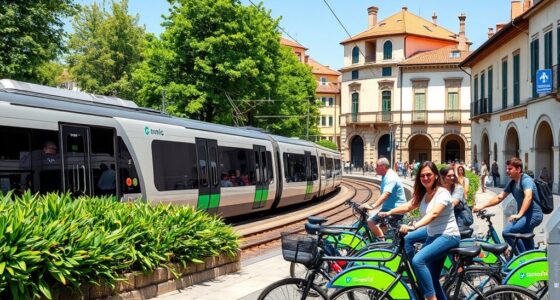Green roofs and urban gardens help you combat rising temperatures in Italian cities by providing shade, insulation, and cooling effects that reduce the urban heat island impact. They also absorb rainwater, lowering flood risks and filtering pollutants, which improves water quality. Plus, these green spaces support local biodiversity, making your city more resilient and vibrant. If you want to discover how these features boost climate resilience and urban comfort, keep exploring further.
Key Takeaways
- Green roofs and urban gardens reduce the urban heat island effect by providing shade and insulation in Italian cities.
- They lower temperatures, decreasing energy demand for cooling and reducing greenhouse gas emissions.
- These green spaces absorb rainwater, mitigating runoff and flood risks during heavy rainfall events.
- They support biodiversity by creating habitats and wildlife corridors within dense urban environments.
- Green roofs and gardens enhance urban aesthetics and ecological health, promoting sustainable and resilient city living.

Green roofs and urban gardens are transforming cityscapes by bringing nature back into densely built environments. In Italian cities, where heat can soar during summer months, these green spaces serve as essential tools to combat rising temperatures. Not only do they reduce the urban heat island effect, but they also offer practical benefits like stormwater management and biodiversity enhancement. As you incorporate these features into your cityscape, you’re actively helping to manage heavy rainfall. Green roofs absorb rainwater, slowing runoff and reducing the burden on drainage systems, which is especially critical during heavy storms. This process minimizes the risk of flooding and water pollution, making urban areas more resilient to climate extremes. Simultaneously, urban gardens create habitats that support a variety of species, from pollinators to birds, thereby boosting biodiversity. This isn’t just about beautifying rooftops; it’s about creating interconnected ecosystems that sustain local flora and fauna, contributing to ecological health amid dense urban settings.
When you prioritize stormwater management through green roofs, you’re also improving water quality. Excess runoff often carries pollutants into rivers and lakes, but absorption by green roofs filters some contaminants and reduces the volume of runoff entering water bodies. This process helps maintain cleaner waterways and supports local aquatic life. Additionally, by planting native species and creating wildlife corridors within urban gardens, you foster biodiversity enhancement. These green spaces attract beneficial insects, birds, and small mammals, enriching the urban environment and supporting natural pest control. Such ecological diversity makes city ecosystems more robust and adaptable to environmental stresses.
Furthermore, green roofs and urban gardens help lower ambient temperatures by providing insulation and shade, which directly mitigates heat stress for residents. As you witness the cooling effects, you’ll notice reduced energy demands for air conditioning, leading to lower greenhouse gas emissions. This sustainable approach doesn’t just improve comfort; it actively fights climate change by reducing your city’s carbon footprint. Incorporating biodiversity hotspots into urban planning can further enhance ecological resilience and species richness. The combination of stormwater management, biodiversity enhancement, and cooling effects makes green roofs a holistic solution for Italian cities facing increasing heat and weather variability.
In embracing these green initiatives, you’re part of a movement that redefines urban living. You’re turning concrete jungles into vibrant, resilient environments where nature and people coexist harmoniously. The benefits extend beyond individual rooftops, creating healthier, cooler, and more sustainable cities. As you see more buildings adorned with greenery, you’ll realize that integrating nature into urban design isn’t just aesthetic — it’s essential for adapting to a changing climate and ensuring a better quality of life for everyone.
Frequently Asked Questions
How Do Green Roofs Affect Building Energy Costs Long-Term?
Green roofs lower your building’s energy costs long-term by boosting energy efficiency and reducing cooling and heating demands. You’ll notice significant cost savings as the insulation keeps indoor temperatures stable, cutting down on energy use. Over time, these roofs pay for themselves through lower utility bills, while also providing environmental benefits. Implementing green roofs is a smart way to save money and promote sustainable urban living.
What Are the Maintenance Requirements for Urban Gardens in Italy?
You need to stay on top of irrigation schedules to keep your urban garden healthy, especially during hot Italian summers. Regular watering prevents stress on plants, and adjusting schedules based on weather conditions is vital. Additionally, pest management is indispensable; inspect plants frequently and use eco-friendly solutions to prevent infestations. Consistent maintenance ensures your garden thrives, enhances urban cooling, and minimizes long-term upkeep costs.
Are There Specific Plant Species Best Suited for Italian Climates?
You should choose native Italian flora and drought-tolerant plants for your garden. These species thrive in Italy’s climate, resist drought, and require less maintenance, making them ideal. Olive trees, lavender, rosemary, and succulents are excellent options. They adapt well to local soil and weather conditions, ensuring your garden stays vibrant and sustainable. By selecting these plants, you create a resilient, beautiful space that benefits both you and the environment.
How Do Green Roofs Contribute to Local Biodiversity?
Green roofs boost local biodiversity by providing habitat diversity, attracting native pollinators like bees and butterflies. You help support the ecosystem when you install and maintain these roofs, creating safe spaces for wildlife amidst urban areas. This encourages a healthy, balanced environment, strengthening native populations and promoting plant pollination. As a result, you’re actively contributing to a more resilient city ecosystem, benefiting both nature and your community.
What Funding Options Are Available for Urban Green Projects in Italy?
Imagine planting seeds for a greener future; Italy offers various funding options for urban green projects. You can access financial incentives and public grants from local governments, EU programs, and environmental agencies. For instance, some cities like Milan provide subsidies for green roofs. These resources make it easier for you to develop sustainable spaces, reducing urban heat and enhancing city life. Don’t miss out—explore available grants and incentives today.
Conclusion
Embracing green roofs and urban gardens is like planting hope amid concrete jungles. They serve as living shields, cooling cities and nurturing life where it’s needed most. By adopting these green havens, you become a steward of change, turning rooftops into symbols of resilience and renewal. Together, we can transform our urban landscapes into lush, vibrant sanctuaries—proof that even small acts can bloom into powerful solutions for a hotter, harsher world.









